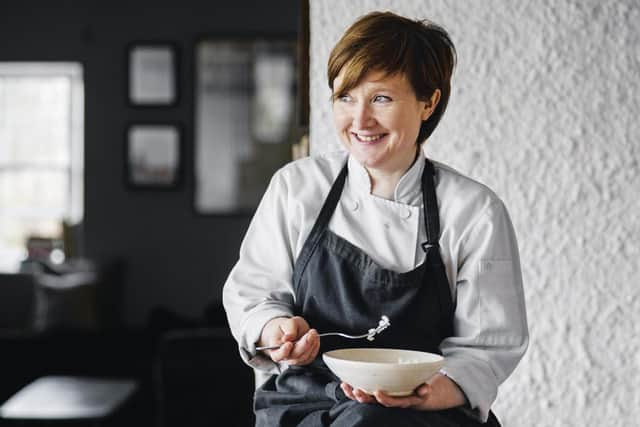The new Phaidon cookbook, Today's Special, pays tribute to two of the most exciting chefs in Scotland


The new Phaidon book, Today's Special: 20 Leading Chefs Choose 100 Emerging Chefs, out today, involved asking culinary icons, who's next? Margot Henderson OBE, had two Scottish nominees in mind - James Ferguson of The Kinneuchar Inn, Kilconquhar, and Pamela Brunton of Inver, Cairndow, whose recipe (not for beginners) is extracted below, preceded by Margot’s tribute.
“In the kitchen of a white cottage overlooking Scotland’s longest sea loch, Pamela Brunton transforms the larder of the landscape into dishes she describes as “modern Scottish.” This cozy establishment, called Inver, is tucked away on a bay just outside the nearest hamlet, Strathlachlan. Brunton’s menus nod to the regional cuisine while incorporating elements from the surrounding landscape with rigor and playfulness. Brunton imbues her menus with both the historic and geographic influences of her milieu.
Advertisement
Hide AdAdvertisement
Hide AdOysters, mussels, and langoustines come from the lochs; samphire, sorrel, and mustard are harvested from the adjacent marshes and forests. In June, a walk down the road or in a meadow can yield thousands of coral-hued salmonberries. Innovative dishes with traditional touches include duck served in a fragrant bowl of baked-potato-skin broth, draped with Scottish truffles, or mackerel garnished with fermented coffee, oil of voatsiperifery, and cultured cream. Her take on fish and chips: raw and pickled.
In 2015, Brunton opened Inver with her partner, Rob Latimer, after about a decade of working her way through Michelin-starred restaurants and beacons of New Nordic cuisine. Her roots are grounded in French technique learned at places in London, including the Tom Aikens Restaurant, the Greenhouse, and the restaurants of Marco Pierre White, and in France, at Le Moulin de l’Abbaye. Stints at Noma, Fäviken, and In De Wulf also influenced her passion for translating the landscape to the plate. While Brunton’s time at such establishments gave her the skills, experience, and determination to realize her vision for Inver, she remembers that her palate developed at an early age, awakened and then fine-tuned by the steady supply of vegetables from her mother’s garden. But she never considered a career as a chef until she abandoned university, where she had been studying philosophy. She tried bartending, then got work at a seafood joint near the Isle of Skye in Scotland. In that kitchen, she formed, for the first time, a true identity: she was a chef. At Inver, Brunton’s connection to a sense of place and time, both present and past, is felt immediately by anyone who comes to eat in her kitchen”.
GIGHA HALIBUT, COASTAL GREENS, AND SMOKY MUSSEL BUTTER
Serves 10–12
For the smoked mussel stock:


1 kg mussels, scrubbed, 1 shallot, sliced, 75 ml white wine, 75 ml water
For the smoky mussel butter:200 ml hot Smoked Mussel Stock (above), 275 g cold unsalted butter, diced, 30 ml fresh lemon juice
Pinch of sea salt
For assembly:
1 (150 g) piece Gigha halibut fillet per person (from a whole fish that weighed 4–5 kg)Fine sea saltNeutral oil, for cooking the halibutFlaky sea saltLemons, for squeezingVarious seashore greens, like samphire, sea blite, sandwort, sea aster, sea plantain, and arrowgrass, and seaweeds like sea spaghetti and dulse1 piece of halibut “skirt” per person, breadcrumbed and deep-friedA few mussels per personCrispy fried dulseSeaweed “tartar sauce”: ground pepper dulse, capers, finely diced shallots, and lots of lemon juice
Make the smoked mussel stock:
In a deep pan, about twice the height of the level of the unopened mussels, combine the mussels, shallot, wine, water, and shallot. Cover and bring to a boil, then reduce the heat and simmer for 45 minutes. Remove from the heat. Let the mussels infuse in their liquor for 45 minutes. Tip the lot into a large colander set over a bowl, mixing the mussels around to allow all the juice to drain out the shells into the bowl.
Strain the stock through a fine-mesh sieve lined with cheesecloth (muslin).
Reserve half of the spent mussels. Pick the mussel meat from the shells. Smoke the mussels over hay for 20 minutes, stirring the mussels and relighting the hay after 10 minutes.
Advertisement
Hide AdAdvertisement
Hide AdBring the stock to a simmer, then remove from the heat. Add the smoked mussels to the hot stock and infuse the stock for 30 minutes. Strain again into a saucepan. Reduce the mussel liquor by around one- third to 200 ml.
Make the smoky mussel butter:
Using a hand blender, add the diced butter to the hot stock one piece at a time, blending until emulsified after each addition. Season with the lemon juice and salt.
To assemble:
Warm the mussel butter. Lightly season the halibut with fine sea salt. In a frying pan, heat a little oil over high heat until hot. Add the halibut skin-side down and cook without moving for 1 minute, then reduce the heat and continue to cook for another 2 minutes. Add a little butter to the pan and when it melts and foams, spoon the hot butter over the fish to finish the cooking. It should take no longer than 4 minutes to cook through sufficiently. Remove from the pan and season with flaky sea salt and a squeeze of lemon juice. Meanwhile, lightly blanch the greens in boiling water, fry the halibut skirt, and steam open the mussels.
Transfer the cooked fish to a shallow bowl or plate, add the greens, mussels, crispy seaweed, and puffed skin to the side of the fish, so it all looks a little like a tideline after a storm, and spoon over the smoky mussel butter sauce. Serve the crispy crumbed halibut skirt on the side, with the seaweed tartar sauce.